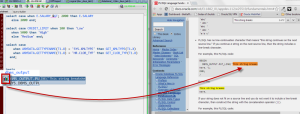

- SQL DEVELOPER CODE FORMATTER INSTALL
- SQL DEVELOPER CODE FORMATTER TRIAL
- SQL DEVELOPER CODE FORMATTER PASSWORD
- SQL DEVELOPER CODE FORMATTER PC
- SQL DEVELOPER CODE FORMATTER PLUS
Aside from this, it is also a problem to make changes in this code fast. Of course it is obvious that the first query is not very easy to read. Now compare that with the formatted query below, which is the same code:ĭo you see the difference? Which is more readable? Which query is easier to understand? This SQL query above has been written without using any formatting rules. SELECT id, FirstName, LASTNAME,c.nAme FROM people p left JOIN cities AS c on c.id=p.cityid If you think formatting is something that can be safely ignored, look at the code below: Why is it Worthwhile to Format SQL Code?īeginner SQL programmers often don't pay much attention to formatting their code. In this article I discuss why this is so important and what are the basic rules you should follow. Best practices for writing professional SQL code require good formatting skills. Finally, just press Enter to execute the code, if it is not already executed.Writing queries to a database requires knowledge about SQL syntax, but this is not all you should know. If you are not using a file to execute the PL/SQL scripts, then simply copy your PL/SQL code and right-click on the black window that displays the SQL prompt use the paste option to paste the complete code at the command prompt. Type at the SQL*Plus command prompt to execute your program. Launch the SQL*Plus command prompt from the directory where you created your PL/SQL file. Type your code in a text editor, like Notepad, Notepad+, or EditPlus, etc. It is always recommended to use the command files. Running large programs from the command prompt may land you in inadvertently losing some of the work. You should have the SQL prompt where you will write your PL/SQL commands and scripts − Text Editor At the command prompt, use the following command if you are using Windows − It is now time to verify your installation. Upon installation, you will have the following final window. Once the database files are copied, you will have the following dialogue box. Here, Oracle installation will copy the required configuration files. This will take a few moments, until Oracle starts performing the required configuration. Step 7Ĭlick the Finish button to proceed this will start the actual server installation. Step 6Īgain, click the Next button to proceed. Once you provide the required information, click the Next button to proceed.
SQL DEVELOPER CODE FORMATTER PASSWORD
You will also have to provide a password this will be used by the system DBA. Just modify the Oracle Base and the other locations will set automatically.
SQL DEVELOPER CODE FORMATTER INSTALL
Provide a location, where you will install the Oracle Server. Thus, select the Desktop Class option and click the Next button to proceed.
SQL DEVELOPER CODE FORMATTER PC
We assume you are installing Oracle for the basic purpose of learning and that you are installing it on your PC or Laptop.

Just select the first option Create and Configure Database using the radio button and click the Next button to proceed. You will be directed to the following screen uncheck the checkbox and click the Continue button to proceed. You can provide your email ID and check the checkbox as shown in the following screenshot. Let us now launch the Oracle Database Installer using the setup file. You will also use similar steps on your operating system, does not matter if it is Linux or Solaris.Īfter downloading the above two files, you will need to unzip them in a single directory database and under that you will find the following sub-directories − Step 1 You will have to download either the 32-bit or the 64-bit version of the installation as per your operating system.
SQL DEVELOPER CODE FORMATTER TRIAL
You can download a trial version of Oracle 11g from the following link − The most recent version of Oracle RDBMS is 11g. This will take care of the execution of the SQL commands. To run PL/SQL programs, you should have the Oracle RDBMS Server installed in your machine. Once the statements are processed, the results are sent back and displayed on screen. These commands are then sent to the database for processing.
SQL DEVELOPER CODE FORMATTER PLUS
SQL* Plus is an interactive tool that allows you to type SQL and PL/SQL statements at the command prompt. PL/SQL is not a standalone programming language it is a tool within the Oracle programming environment. In this chapter, we will discuss the Environment Setup of PL/SQL.


 0 kommentar(er)
0 kommentar(er)
